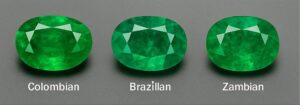How to Identify Real Emeralds: A Comprehensive Guide for Buyers and Collectors
Discover how to distinguish genuine emeralds from imitations with expert tips on color, clarity, inclusions, and certification.
1. Understanding What a Real Emerald Is
Emeralds are a variety of the mineral beryl, colored green by trace amounts of chromium and/or vanadium. True emeralds are:
- Natural: Formed deep within the Earth over millions of years.
- Rare: Especially high-quality stones with vivid green color and good clarity.
- Treated (often): Most emeralds are oiled with cedarwood oil to enhance clarity—a widely accepted and traditional practice.
2. Visual Characteristics of Genuine Emeralds
Color
- Hue: Rich green to bluish-green.
- Tone: Neither too dark nor too light.
- Saturation: Vivid, intense color is most valuable.

Clarity
Natural emeralds almost always have inclusions, known as “jardin” (French for garden). These may look like tiny fractures, mossy threads, or bubbles. A perfectly clear emerald is likely synthetic or a simulant.
Cut
Emeralds are commonly cut into emerald, oval, pear, or Asscher shapes. Facets may be slightly soft due to the stone’s brittleness.
3. Common Emerald Imitations and Synthetics
Green Glass
- Lacks natural inclusions
- Softer than emerald (can scratch easily)
- Often contains bubbles visible under magnification
Synthetic Emeralds
Lab-grown but chemically identical to natural emeralds. May have no inclusions or show synthetic growth patterns. Often labeled as “hydrothermal” or “flux-grown.”
Doublets and Triplets
Constructed gemstones that fuse a thin emerald layer with glass or other materials. Easy to spot under magnification or good lighting.
4. Testing Methods to Identify Emeralds
- Loupe or Microscope Inspection: Look for inclusions or bubbles.
- UV Light Test: Natural emeralds typically do not fluoresce.
- Refractive Index: 1.577 to 1.583 (use a gemological refractometer).
- Specific Gravity: 2.67–2.78.
- Professional Lab Testing: GIA, CDTEC, Gübelin, GRS and others offer certified reports.
5. Certifications and Why They Matter
Always request a certified gemological report. Trusted labs confirm:
- Natural vs synthetic
- Treatments applied
- Geographic origin (e.g., Colombia, Zambia)
Certification protects your investment and adds value to your emerald.
6. Tips for Buyers
- Buy from trusted sellers: Look for transparency, return policies, and verified listings.
- Ask about treatments and origin.
- Use escrow services: Escrow.com provides buyer protection for high-value gemstones.



